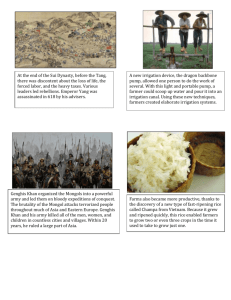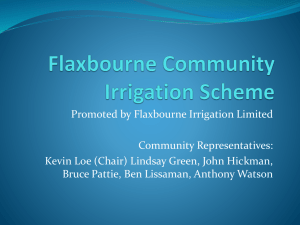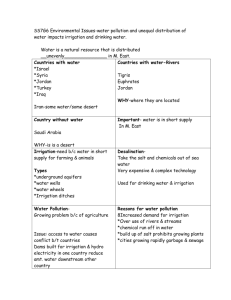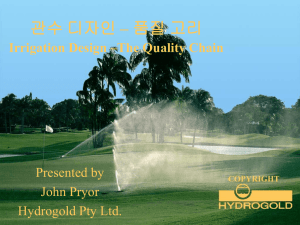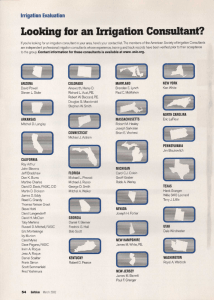ANALYSIS OF IRRIGATION WATER REQUIREMENTS IN RICE FIELDS IN SP4, TANAH MIRING DISTRICT, MERAUKE REGENCY
advertisement
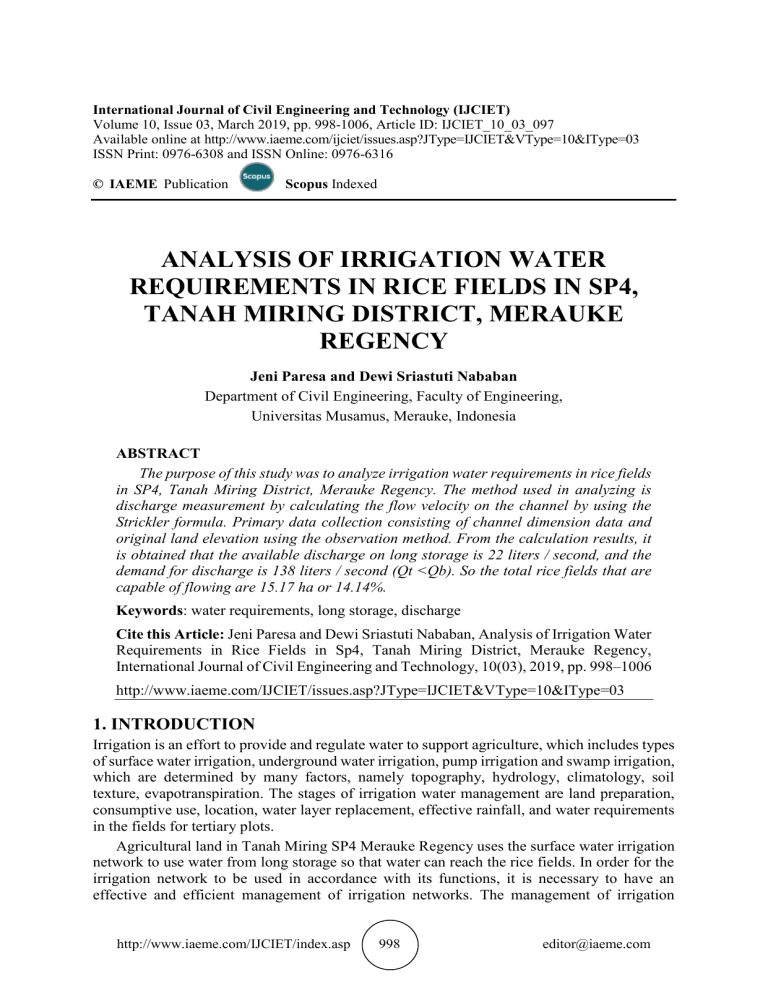
International Journal of Civil Engineering and Technology (IJCIET) Volume 10, Issue 03, March 2019, pp. 998-1006, Article ID: IJCIET_10_03_097 Available online at http://www.iaeme.com/ijciet/issues.asp?JType=IJCIET&VType=10&IType=03 ISSN Print: 0976-6308 and ISSN Online: 0976-6316 © IAEME Publication Scopus Indexed ANALYSIS OF IRRIGATION WATER REQUIREMENTS IN RICE FIELDS IN SP4, TANAH MIRING DISTRICT, MERAUKE REGENCY Jeni Paresa and Dewi Sriastuti Nababan Department of Civil Engineering, Faculty of Engineering, Universitas Musamus, Merauke, Indonesia ABSTRACT The purpose of this study was to analyze irrigation water requirements in rice fields in SP4, Tanah Miring District, Merauke Regency. The method used in analyzing is discharge measurement by calculating the flow velocity on the channel by using the Strickler formula. Primary data collection consisting of channel dimension data and original land elevation using the observation method. From the calculation results, it is obtained that the available discharge on long storage is 22 liters / second, and the demand for discharge is 138 liters / second (Qt <Qb). So the total rice fields that are capable of flowing are 15.17 ha or 14.14%. Keywords: water requirements, long storage, discharge Cite this Article: Jeni Paresa and Dewi Sriastuti Nababan, Analysis of Irrigation Water Requirements in Rice Fields in Sp4, Tanah Miring District, Merauke Regency, International Journal of Civil Engineering and Technology, 10(03), 2019, pp. 998–1006 http://www.iaeme.com/IJCIET/issues.asp?JType=IJCIET&VType=10&IType=03 1. INTRODUCTION Irrigation is an effort to provide and regulate water to support agriculture, which includes types of surface water irrigation, underground water irrigation, pump irrigation and swamp irrigation, which are determined by many factors, namely topography, hydrology, climatology, soil texture, evapotranspiration. The stages of irrigation water management are land preparation, consumptive use, location, water layer replacement, effective rainfall, and water requirements in the fields for tertiary plots. Agricultural land in Tanah Miring SP4 Merauke Regency uses the surface water irrigation network to use water from long storage so that water can reach the rice fields. In order for the irrigation network to be used in accordance with its functions, it is necessary to have an effective and efficient management of irrigation networks. The management of irrigation http://www.iaeme.com/IJCIET/index.asp 998 editor@iaeme.com Analysis of Irrigation Water Requirements in Rice Fields in Sp4, Tanah Miring District, Merauke Regency networks will affect the system of giving water to rice fields and the level of irrigation services received by farmers. In the dry season the water needs in the Tanah Miring SP4 rice fields in Merauke Regency have not been fulfilled, thus affecting farmers' production due to long storage that cannot function properly. According to KP-01 Irrigation Planning Standards, Irrigation is a system of providing water to agricultural land to meet the needs of plants so that the plants grow well. And also according to Government Regulation No.23 of 1998 irrigation is an effort to provide and regulate water to support agriculture, and according to Government Regulation No.20 of 2006 is an effort to provide regulation and disposal of irrigation water to support agriculture whose types include surface irrigation, swamp irrigation, underground water irrigation, pump irrigation, and pond irrigation. Each plant must need water in its life cycle (Mangkoedihardjo and April, 2012), while rain is the main water source for plants. Changes in water supply for plants caused by changes in certain rainfall conditions will greatly affect plant growth, so this change will cause a decline in agricultural production. 2. METHODOLOGY The measurement of discharge in this study was obtained by calculating the flow velocity on the channel using the Strickler formula. Primary data collection consisting of channel dimension data and original land elevation using the observation method. 2.1. Effective rainfall Effective rainfall is estimated for the next stage, which is estimated conservatively from rainfall to have a probability of 80%, R80. Some of the falling rain water will flow into the surface water system before it can be used effectively by plants, effective rainfall is assumed to be 70% of the total rainfall. Re = 0,7 x R80 where: Re = effective rainfall (mm/day) R80 = reliable rain (mm) 2.2. DEFINITION OF IRRIGATION According to government regulation No.23 of 1998 irrigation is an effort to provide and regulate water to support agriculture, and according to government regulation No.20 of 2006 is an effort to provide regulation and disposal of irrigation water to support agriculture whose types include surface irrigation, swamp irrigation, irrigation underground water, pump irrigation, and pond irrigation. Irrigation comes from the term irrigaite in Dutch or irrigation in English. Irrigation can be interpreted as an effort carried out to bring water from its source for agricultural purposes, flow and distribute water regularly and after use can also be thrown back. 2.3. Alternative cropping patterns Cropping patterns are general forms of planting schedules which state when to start planting rice, secondary crops, sugar cane and so on. The form of the pattern to be applied depends on the conditions of the area and the availability of water in the Irrigation Area, for example: 1. If there is a lot of water available, a rice-paddy cropping pattern can be done. http://www.iaeme.com/IJCIET/index.asp 999 editor@iaeme.com Jeni Paresa and Dewi Sriastuti Nababan 2. If rice with superior variety is used (age <140 days), it is still possible to plant secondary crops so that the cropping pattern becomes: Paddy-Rice. 3. If the water supply in the dry season is limited, then for paddy fields that get water difficulties in the dry season, they will apply the planting pattern: Paddy-Palawija-Palawija. 4. If an area is required to plant sugar cane for more than 1 year (ie ± 15 months). 2.4. Estimated monthly plant coefficient In analyzing our normal water requirements, we will not be separated from the ability of evapotranspiration plants, therefore an estimate of the monthly plant coefficient is made where plant growth is based on the type of rice plant and the age at which it starts, the highest need when the plant has reaching the middle age of the entire production age. 2.5. Water requirements for processing paddy fields Pre-irrigation is needed to work on land to be planted and to create adequate humid conditions for newly-grown nurseries. To calculate the normal water requirements in managing paddy fields, it is usually influenced by the texture and structure of paddy fields, the effect of the previous land use, soil treatment process. The following is the equation formula for estimating irrigation water requirements. Clean water needs in rice fields for rice: NFR = Etc + P – Re + WLR Irrigation water requirements for rice: IR = NFR e Where: NFR = Clean water needs in the fields (l/sec/ha) IR = Irrigation water needs for rice Etc = Consumptive use (mm) P = Water loss due to percolation (mm/day) Re = Effective rainfall (mm/day) e = Overall irrigation efficiency WLR = Change the water layer 2.6. Water requirements Water needs include the problem of water supply, both surface water and underground water. To find out the amount of water needed / must be provided, it is necessary to know in advance the functions and properties of water in plant processes. If the water needs of a plant are known, the water requirements for a larger unit can be calculated. Water requirements in rice fields are very dependent on land preparation (processing), evaporation that occurs (evapotranspiration), percolation and seepage, change of water layer, effective rainfall, puddles of water in the fields. 1. Use of Evaporation land preparation (Eo) Eo = 1,1 x Eto where: http://www.iaeme.com/IJCIET/index.asp 1000 editor@iaeme.com Analysis of Irrigation Water Requirements in Rice Fields in Sp4, Tanah Miring District, Merauke Regency Eo = Evaporation ETo = Evapotranspiration potential 2. Use of plant consumptions (ETc) ETc = ETo x Kc where: ETc = Use of plant consumptive ETo = Evapotranspiration potential Kc = Plant coefficient 3. Discharge irrigation water (Q) Q = A1 x a x e where: Q = water discharge (l/sec) A1 = area of agriculture (ha) a = amount of water needs (l/sec) e = irrigation efficiency 2.7. Calculation of hydraulic irrigation canals In this Planning Criteria, flow rates are used with maximum permissible prices, not shear forces, as parameters for erosion forces. For hydraulic planning of a channel, there are two main parameters that must be determined if the required capacity plan is known, namely: 1. Comparison of water depth with a base width 2. The slope extends the channel In channel planning, there are three conditions that must be distinguished due to the presence of sediments in irrigation water and embankment material, namely: 1. Irrigation without sediment in the soil channel. 2. Irrigated water is sedimented on the couple's canal. 3. Sediment irrigation flows in the land channel. For segment planning, the channel flow is considered a fixed flow, and for that the Stricker formula (DPU 2010) is applied: V = K ∙ R2/3 ∙ I1/2 Q=V∙A R = A/P A = (b + m h) h 2 P b 2 h (1 m ) N = b/h where: A = (b + m h) h Q = Channel discharge, ( m3/sec ) V = Flow speed, (m/sec) A = Wet cross section area (m2) R = Hydraulic fingers, ( m ) P = Wet circumference, ( m ) http://www.iaeme.com/IJCIET/index.asp 1001 editor@iaeme.com Jeni Paresa and Dewi Sriastuti Nababan b = Base width, ( m ) h = Depth water, ( m ) I = Channel slope K = Strickler coefficient of roughness, (m1/3/sec) m = Slope of the talud The cross section of the trapezium channel can be seen in figure 1 below. Figure 1. Cross Section Parameters 2.8. Long Storage Long storage is a small water reservoir or reservoir at the location of agriculture that aims to accommodate excess rainwater in the rainy season and its use in the dry season for various needs both in agriculture and the interests of the community. The formula for calculating the amount of long storage, theoretically can be found in Mangkoedihardjo (2010), but practically can use the following equation: Vol. = (B L b l) 2 xT where: Vol. = storage volume B = first parallel side b = second parallel side L = first channel length l = second channel length T = channel height http://www.iaeme.com/IJCIET/index.asp 1002 editor@iaeme.com Analysis of Irrigation Water Requirements in Rice Fields in Sp4, Tanah Miring District, Merauke Regency 3. RESULTS AND DISCUSSION 3.1. Results Table 1. The Amount of ETo for the First Planting Period Paramete r Unit ETo mm/hr Month / 2 weekly January I II 16 15 4.50 4.22 February I II 14 14 3.69 3.69 March I II 16 15 3.67 3.45 April I 15 3.02 II 15 3.02 Table 2. The amount of ETo for the second planting period Parameter Unit ETo mm/hr Month / 2 weekly August September I II I II 16 15 15 15 3.69 3.69 3.67 3.45 July I 16 4.50 II 15 4.22 October I II 16 15 3.02 3.02 Eo calculation of land preparation in the first week of the first month: Eo = 1.1 x ETo ; ETo = 4.50 =1.1 x 4.50 = 4.95 mm/hr Obtained the same thing for land preparation in the first two weeks and obtained: Eo = 4.64 mm/hr. Calculation of Eo land preparation in the first week of the first month: Eo = 1.1 x ETo ; ETo = 2.95 =1.1 x 2.95 = 3.25 mm/hr. Obtained the same thing for land preparation in the first two weeks and obtained: Eo = 3.05 mm/hr. Calculation of consumptive use of water for the first week of the second month: ETc = ETo x Kc =3.69 x 1.1 = 4.06 mm/hr. Table 3. Calculation of ETc During the First Planting Period Month Second Third Fourth Week First Second First Second First Second ETc 4.06 mm/hr 4.06 mm/hr 3.85 mm/hr 3.62 mm/hr 2.87 mm/hr mm/hr Use of consumptive water for the first week of the second month: ETo = ETo x Kc = 4.27 x 1.1 = 4.70 mm/hr. http://www.iaeme.com/IJCIET/index.asp 1003 editor@iaeme.com Jeni Paresa and Dewi Sriastuti Nababan Table 4. Calculation of ETc during the second planting period Month Week First Second First Second First Second Second Third Fourth ETc 4.70 mm/hr 4.40 mm/hr 5.89 mm/hr 5.89 mm/hr 6.40 mm/hr 0 mm/hr 3.2. Discharge irrigation water needs (Q) Table 5. Calculation of Quaternary Channel Discharge During the First Planting Period Name No of channel Area Water needs Channel efficiency (A1 ) (a) (e) 1 BT 1 2 BT 2 4 BT 3 Total needs 20 38 37 95 1.4 1.4 1.4 0.65 0.65 0.65 Q (m/ sec) 0.018 0.035 0.034 0.087 Table 6. Calculation of Quarterly Channel Discharge During Second Planting Period Number 1 2 4 Name of channel BT 1 BT 2 BT 3 Total needs Area Water needs Channel efficiency ( A1 ) (a) (e) 20 38 37 95 2.23 2.23 2.23 0.65 0.65 0.65 Q (m/ sec) 0.029 0.055 0.054 0.138 3.3. Long storage capacity From direct measurements obtained values of b = 18 m, t = 5.5 m, B = 29 m, p = 1789 m, and P = 1800 m. So that it can use equations: ((29 18000) (18 1789)) 5,5 2 V = (46250 27600) 2 = x 5.5 3 = 232105.5 m Potential evapotranspiration (Et0) and maximum percolation during the second planting period. Et0 + P = 13,06 + 2 = 15,06 mm/day = 15,06 x 123 day http://www.iaeme.com/IJCIET/index.asp 1004 editor@iaeme.com Analysis of Irrigation Water Requirements in Rice Fields in Sp4, Tanah Miring District, Merauke Regency = 1852,38 mm/season = 1,852 m/season The total maximum storage capacity for long storage is: Q = 232105,5 – 1,852 = 232103,648 1887,021 = 123 m3/day = 3070,042 (24 60 60) = 0.022 m3 3.4. Balance of water needs Table 7. Comparison Between Qb with Qt Name of Channel Tersier 1 Tersier 2 Total Qavailable Real (Long Storage) 0.022 m3 0.022 m3 Qneeds First Second 0.053 m3/sec 0.034 m3/sec 0.087 m3/sec 0.084 m3/sec 0.054 m3/sec 0.138 m3/sec From the table above it can be seen that long storage discharges have a water deficit on tertiary 1 and tertiary channels 2 for the first and second planting periods taken at 0.116 m3 / sec = 116 l / sec. 4. DISCUSSION From the results of the research obtained, it is for consumptive plants during the first planting period for tertiary channels 1 which is equal to Qb = 0.053 m3 / sec, while the consumptive needs of plants during the first planting period for tertiary 2 are Qb = 0.034 m3 / sec. For the consumptive needs of plants during the second planting period for tertiary channels 1 amounting to Qb = 0.084 m3 / sec, while the consumptive needs of plants in the second crop period for tertiary channels 2 amounted to Qb = 0.054 m3 / sec. So the total requirement for the first planting period is Qb = 0.087 m3 / sec, and for the second planting period is Qb = 0.138 m3 / sec. To meet the needs of these plants obtained from long storage with discharge Qt = 0.022 m3 / sec. From long storage discharges, there was a water deficit in tertiary 1 and tertiary channels 2 and the largest deficit in the second planting period was 0.116 m3 / sec = 116 l / sec. 5. CONCLUSION Based on the results of the research conducted, it can be concluded that the discharge available at long storage is 22 liters / second, and discharge needs are 138 liters / second (Qt <Qb). Of the total area of 95 ha which is capable of flowing using long storage discharges, it is 15.17 ha or 14.14%. So that other sources are needed to be able to meet the water deficit that occurs during the first and second planting periods. http://www.iaeme.com/IJCIET/index.asp 1005 editor@iaeme.com Jeni Paresa and Dewi Sriastuti Nababan REFERENCES [1] [2] [3] [4] [5] [6] [7] [8] [9] [10] [11] [12] [13] [14] [15] [16] D. Melisa, “Evaluasi Kapasitas Perencanaan Embung Untuk Kebutuhan Irigasi Di Desa Seifulu Kabupaten Simeulue Tengah Nanggroe Aceh Darussalam (NAD),” 2012. Dina Limbong Pamuttu and Hairulla, 2018. Coral Material Characteristics of Kampung Matara of Merauke District as a Concrete Coarse Aggregate, International Journal of Civil Engineering and Technology, 9(9), pp. 708–712. E.S. Suzanne and S.R. Hutapea, Irigasi di Indonesia. Jakarta: PT Pustaka LP3ES Indonesia, 1996. G. Dafit, “Analisis Kapasitas Tampungan Embung Bulakan Untuk Memenuhi Kekurangan Kebutuhan Air Irigasi Di Kecamatan Payakumbuh Selatan,” 2013. Hairulla and Philipus Betaubun, 2018. Engineering of Clay Soil Stabilization with Cement and Fiber on CBR Value for Road Materials in Merauke District. International Journal of Civil Engineering and Technology, 9(8), pp. 562-567. Herbin F. Betaubun and Philipus Betaubun, 2018. Evaluation of the Performance of Traffic Signs for Vehicle Speed Limits in Merauke District. International Journal of Civil Engineering and Technology, 9(8), pp. 568-573. Hermantoro, “Peningkatan Efektivitas Tampungan Embung Melalui Perbaikan Bentuk Dan Dimensi,” 2011. J.S.D.A. Direktorat, “Standar Perencanaan jaringan irigasi KP-01.” Departemen Pekerjaan Umum, Jakarta, 1986. J.S.D.A. Direktorat, “Standar Perencanaan Saluran KP-03.” Departemen Pekerjaan Umum, Jakarta. Mangkoedihardjo, S. 2010. Individual or communal sanitation services?: Decision based on wastewater storage capacity. Advances in Natural and Applied Sciences 4 (3): 226-228. Mangkoedihardjo, S. and April, SAL. 2012. Compost On Evapotranspiration Bed Planted With Yellow Flag For Treatment Of Wastewater Containing Anionic Surfactant. Journal of Applied Sciences Research, 8(3): 1630-1633. Philipus Betaubun and Hairulla, 2018. Compressive Strength and Tensile Tests for Concrete Made from Local Materials from Toftof, Eligobel District. International Journal of Civil Engineering and Technology, 9(8), pp. 574-579. R. A. P Mochamad, “Studi Efisiensi Pemberian Air Irigasi Desa Kutoharjo, Kecamatan Pati, Kabupaten Pati, Jawa Tengah,” 2012. Sudjarwadi, Dasar-Dasar Teknik Irigasi. Yokyakarta: Fakultas Teknik Universitas Gajah Mada, 1987. Sunggono, Buku Teknik Sipil. Bandung: Penerbit Nova, 1995. Suyadi and Hairulla, 2018. Concrete Compressive Strength Using Coarse Aggregate of Palu with Fine Aggregate of Ulilin of Merauke District, International Journal of Civil Engineering and Technology, 9(9), pp. 713–718. http://www.iaeme.com/IJCIET/index.asp 1006 editor@iaeme.com
